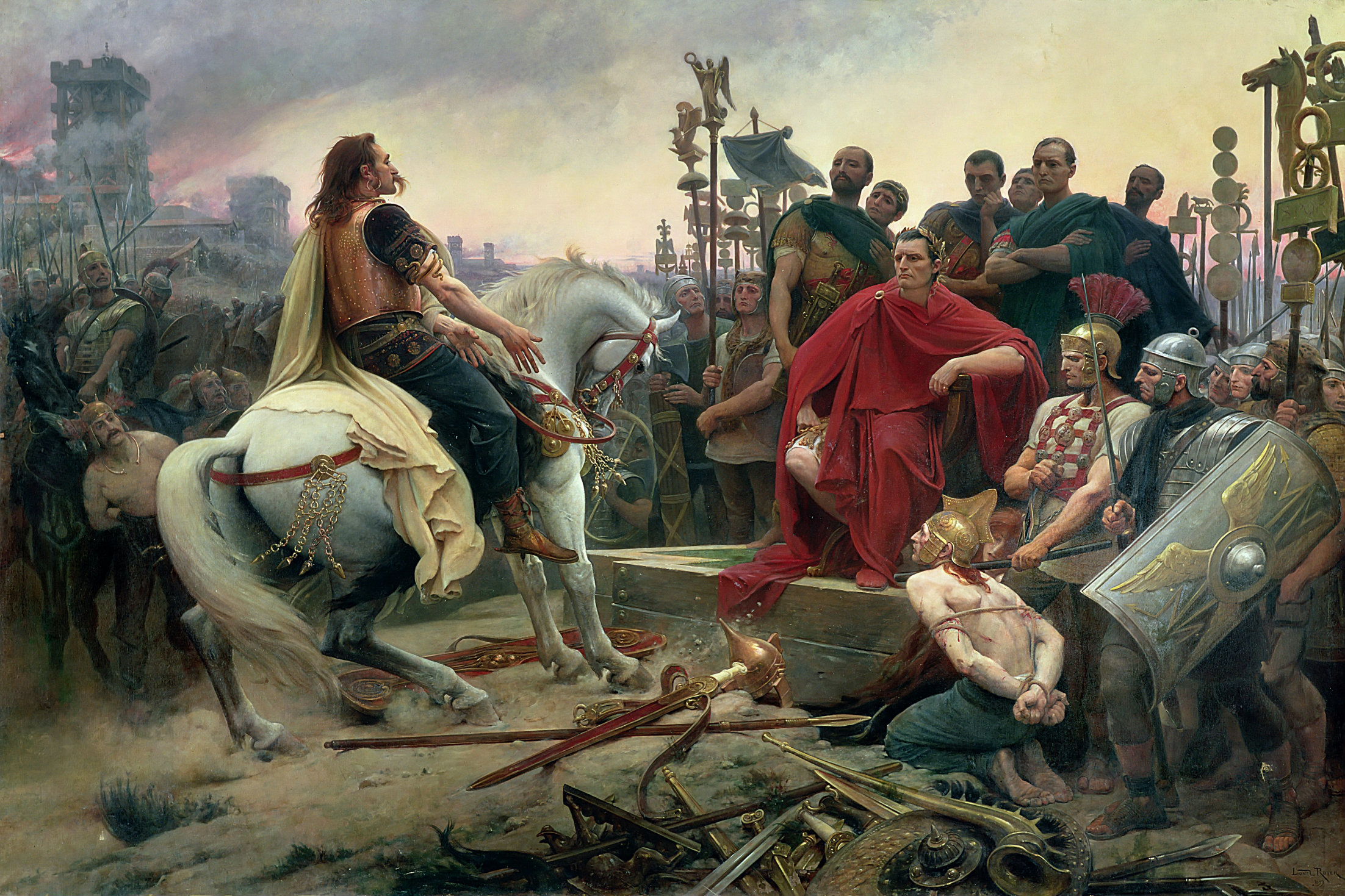“Vercingetorix Throws Down His Arms at the Feet of Julius Caesar” by Lionel Noel Royer, 1899. A famous painting depicting surrender of Gallic Chieftain Vercingetorix to Julius Caesar following the Siege of Alesia during the Gallic Wars.
The warriors of Celtic Europe were among the most distinctive of any fighters in the ancient world. With their great height, long hair and mustaches, frequent nakedness, painted and tattooed bodies, and fondness for collecting enemy heads in battle, Celtic warriors were a fearsome sight to behold.
The Celts were the peoples who spoke the Celtic language and inhabited Western and Central Europe from Iberia to the Danube through the 1st millennium BC and several centuries into the 1st millennium AD. It was during the 4th century BC that Celtic warriors first appeared in Greece, Italy and the Mediterranean islands.
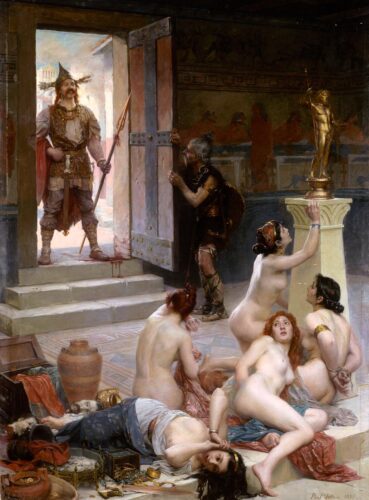
Organization and Tactics
Unlike modern military systems, Celtic groups did not have a standardized regular military. Instead, their organization varied depending on clan groupings and social class within each tribe Endemic warfare was a common and significant aspect of life in Celtic societies. Celtic warriors were famous for the quality of their weapons, their impressive courage and their wild battle-cries. The Celts had unique weapons and tactics that set them apart:
The Celts used a variety of distance combat weapons, including javelins, harpoons, bows, and slings. The stones for the slings were usually taken from rivers, as these were well-formed by the current.
The Celts are notable for their decorative metalworking skills and their short swords are famous for their anthropoid hilts, resembling a human in form. Swords also featured flared hilts that served as hand guards. On the other hand, Celtic long swords usually had oval or disk-shaped buttons at the end of the tang.
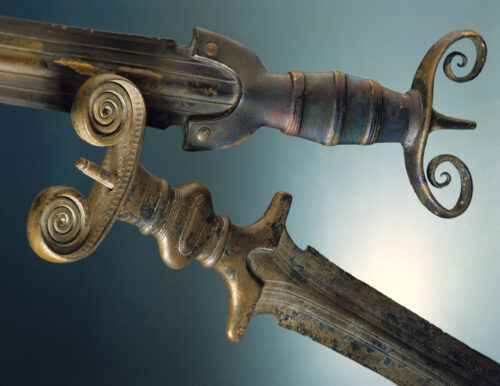
No Celtic tribe had a standardized army, meaning that all Celtic warriors had different equipment from each other. While Celtic Infantry tactics and equipment varied greatly from group to group, they did have some core commonalities. Most would wear baggy trousers and a top with a sword and shield or sometimes a spear. Slingshots, bows, and arrows were also common among them.
Warfare and raiding offered an opportunity for individuals to improve their social standing and acquire loot with which to provide their clients. Many raids were carried out to steal cattle or treasure, the two most important sources of wealth in Celtic society. However, some raids were attempts to conquer nearby groups or polities.
Unlike modern military systems, Celtic groups did not have a standardized regular military. Their organization varied depending on clan groupings and social class within each tribe. The normal Celtic sword fighter was probably a heavy infantryman. They typically fought unarmored in a battle line formation. An exception to this was the nobles who often functioned as heavy cavalry, particularly in Gaul.
The centerpiece of Celtic tactics was the mass charge. Though unarmored, the Celts fought in the manner of heavy infantry, closing with the enemy in dense masses, relying on shock action rather than missile-shooting. On the other hand, they were not drilled to fight as a team, and their principal weapon required space for long sideways or overhead sword-swings.
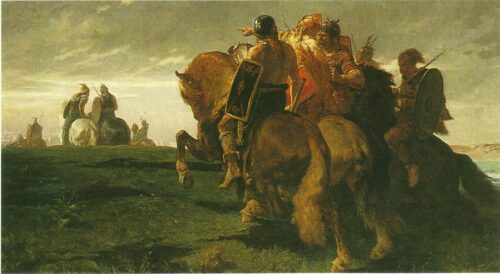
The Celts were known for their use of chariots in warfare, which was quite unique for their time. It played a significant role in their warfare strategies. The Celts, with their advanced iron-working skills, improved the war chariot. These chariots were light, two-wheeled vehicles.
The Celtic chariot served two main purposes in battle. It was used to convey elite warriors from one point on a battlefield to another. It also served as fighting platforms from which to engage the enemy. The use of chariots’ speed to transport warriors was perhaps the foremost benefit of the vehicle.
The ancient writers described the Celtic chariots use as a mixture of cavalry and infantry tactics. The chariot would drive into the battle where the warrior jumps out of the vehicle and fights as an infantry warrior⁴. Once the warrior tired, he would jump back on the chariot. A Roman coin from 110 BC dramatically depicts the naked Gallic warrior-king Bituitus of the Averni casting spears from his chariot.
The Celts participated in several notable battles where chariots played a significant role. During the Second Punic War, Celtic mercenaries joined Carthage and Hannibal in his invasion of the Italian Peninsula. They contributed to his victories in Lake Trasimene and at the Battle of Cannae. Celtic mercenaries notably fought for the Romans against the Parthians at the Battle of Carrha. The famous Celtic queen Boudicca is often depicted with her chariot during her rebellion against the Romans. However, it’s important to note that while Boudicca is often associated with chariots, the historical accuracy of this depiction is sometimes questioned/
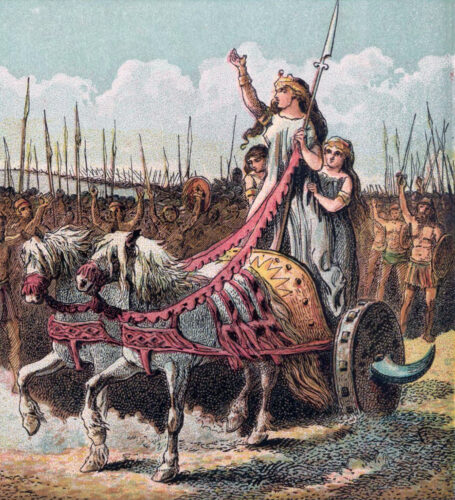
Long overshadowed by their ultimate victors the Romans and others, Celtic warriors such as Brennus (c. 390 AD), Vercingetorix (82-46 BC), Ambiorix (c. 54/53 BC), and Queen Boudicca (d. 61 AD) certainly caused their enemies trouble and impressed them with their determination and valor in battle.
Final Thoughts
The Celts themselves likely had no feeling of belonging to a European-wide race but rather held allegiance to their local tribe or, at most, the confederation their tribe might belong to for the purposes of war. Consequently, any generalized treatment of the Celts must cover a vast geographical area and time period, and the reader is reminded that variations existed in all aspects of Celtic culture including warfare.
While archaeological discoveries offer valuable insights into the material culture of the Celts, determining the precise nature of their ancient combat techniques remains a topic of speculation. Nevertheless, the legacy of the Celtic warriors continues to captivate historians, offering a glimpse into a fascinating chapter of human history.

